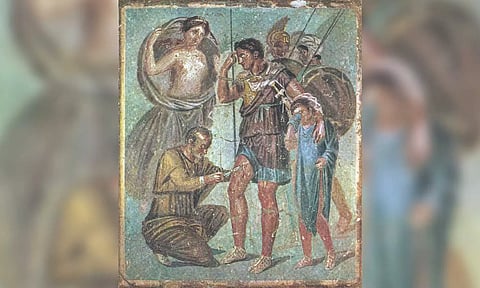

Doctors are generally held in high regard today, but Romans of the first century were skeptical, even scornful, of medical practitioners, many of whom ministered to ailments they did not understand. Poets especially ridiculed surgeons for being greedy, for taking sexual advantage of patients and, above all, for incompetence.
In his “Natural History,” Pliny the Elder, the admiral and scholar who died in 79 A.D. while trying to rescue desperate villagers fleeing the debris of Mt. Vesuvius, endeavoured to speak out against the medical profession “on behalf of the senate and Roman people and 600 years of Rome.” Their fees were excessive, their remedies dubious, their squabbling insufferable. “Physicians gain experience at our peril and conduct their experiments by means of our deaths,” he wrote. The epitaph on more than one Roman tombstone read: “A gang of doctors killed me.”
Medical remedies have improved since those times — no more smashed snails, salt-cured weasel flesh or ashes of cremated dogs’ heads — but surgical instruments have changed surprisingly little. Scalpels, needles, tweezers, probes, hooks, chisels and drills are as much part of today’s standard medical tool kit as they were during Rome’s imperial era.
Archaeologists in Hungary recently unearthed a rare and perplexing set of such appliances. The items were found in a necropolis near Jaszbereny, some 35 miles from Budapest, in two wooden chests and included a forceps, for pulling teeth; a curet, for mixing, measuring and applying medicaments, and three copper-alloy scalpels fitted with detachable steel blades and inlaid with silver in a Roman style. Alongside were the remains of a man presumed to have been a Roman citizen.
The site, seemingly undisturbed for 2,000 years, also yielded a pestle that, judging by the abrasion marks and drug residue, was probably used to grind medicinal herbs. Most unusual were a bone lever, for putting fractures back in place, and the handle of what appears to have been a drill, for trepanning the skull and extracting impacted weaponry from bone.
The instrumentarium, suitable for performing complex operations, provides a glimpse into the advanced medical practices of first-century Romans and how far afield doctors may have journeyed to offer care. “In ancient times, these were comparatively sophisticated tools made of the finest materials,” said Tivadar Vida, director of the Institute of Archaeology at Eotvos Lorand University, or ELTE, in Budapest and leader of the excavation.
Two millenniums ago Jaszbereny and the county around it were part of the Barbaricum, a vast region that lay beyond the frontiers of the Empire and served as a buffer against possible outside threats. “How could such a well-equipped individual die so far from Rome, in the middle of the Barbaricum,” mused Leventu Samu, a research fellow at ELTE and a member of the team on the dig. “Was he there to heal a prestigious local figure, or was he perhaps accompanying a military movement of the Roman legions?”